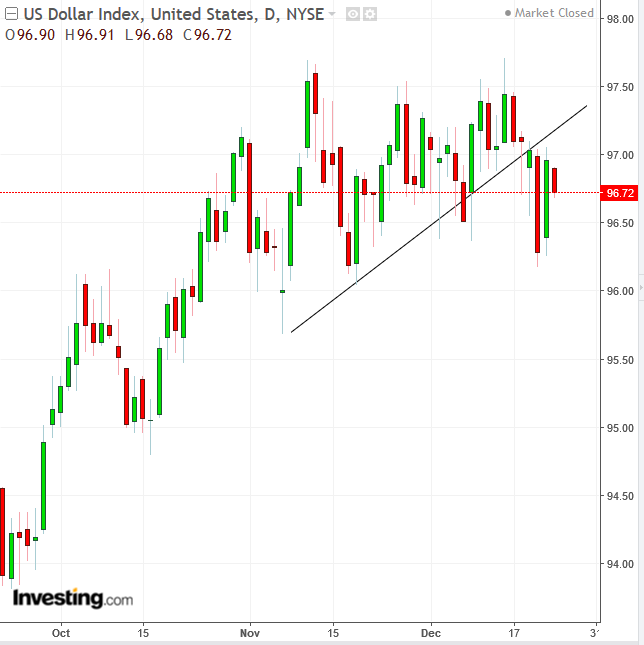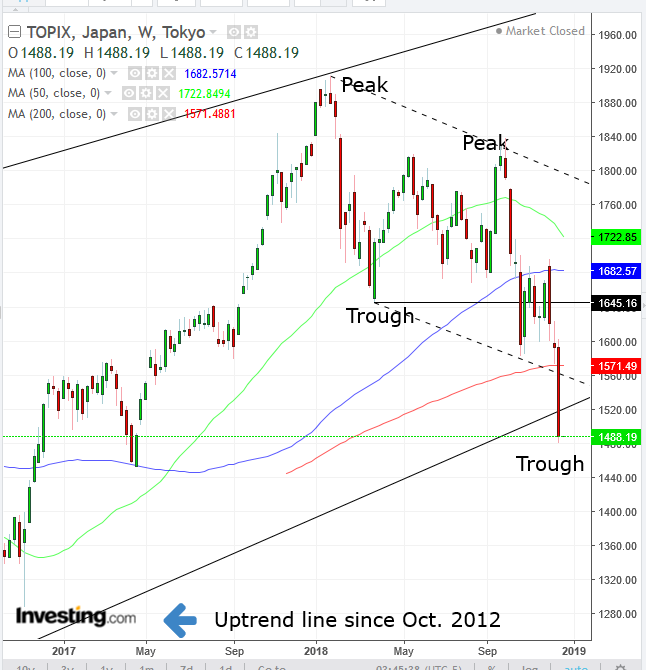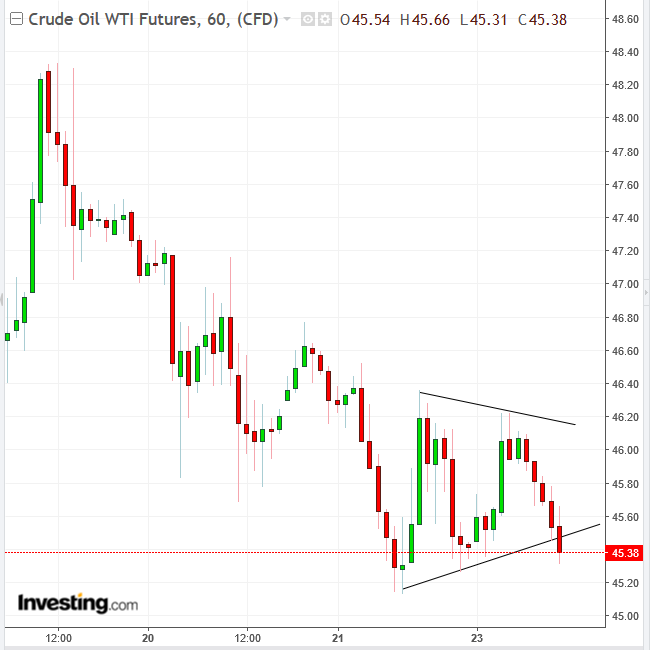- Futures struggle amid heightened political tensions as Mnuchin calls on top banks to reassure investors
- Dollar continues downward trajectory, gold and yen rise
- WTI keeps losing ground, hits 17-month low
Key Events
Futures on the S&P 500, Dow and NASDAQ 100 initially rebounded this morning despite ongoing turmoil out of Washington, but later yielded to downward pressure, slipping rapidly into negative territory. While we had argued that stocks would open higher due to US markets being oversold, with all interested sellers currently out of equities, heightened political jitters seem to be impacting confidence. We had also noted yesterday that the current, partial government shutdown—just 25% of services are closed—wouldn't pose a risk to markets. Historically, even a full government shut down has had no meaningful impact on stocks.
The earlier optimism may have been triggered by US Treasury Secretary Steven Mnuchin’s call to the six largest US banks to reassure investors by confirming that the institutions had enough liquidity available for lending despite the selloff. Mnuchin and other members of the Administration had also tried to limit the impact of Trump’s reported wish to fire Fed Chair Jerome Powell.

As the trading week began, the dollar extended a selloff, after what may prove to be a top, while gold and the yen resumed a rally.
Trading in Europe was on light volume with the German market closed for the holiday. The STOXX 600 rebounded from the lowest level since November 4, 2016, though it was mostly flat, as worries over slowing economic growth and tighter monetary policy weighed on investors. It’s noteworthy that the rebound coincided with a rise in the euro, up about 0.3 percent. Typically, a higher currency would negatively impact the bloc’s exports, lowering company profits.
In earlier Asian trading, regional benchmarks painted a mixed picture. Australia’s S&P/ASX 200 (+0.48%) outperformed, followed closely by China’s Shanghai Composite (+0.43%), while Hong Kong’s Hang Seng (-0.40%) underperformed. South Korea’s KOSPI also dropped, falling -0.31 percent.

Japan’s markets were closed in observance of the Emperor’s Birthday holiday. Last week the Topix tumbled about 6.5 percent, entering a bear market upon falling 20 percent from its January 23 peak amid a strengthening yen—a headwind for an economy so dependent on exports and thereby more precarious in a world beset by trade disputes. Technically, the Topix fell below its uptrend line since October 2012, after dropping through the floor of its falling channel, supported by the 200 WMA, suggesting a steeper decline.
Global Financial Affairs
Friday saw a US stock selloff amid the highest daily volume in years, as several headwinds snowballed into a whirlwind. Quadruple witching, which occurs when index futures, index options, stock futures and stock options expire all at the same time, stepped up pressure on shares that had already taken a beating from an unexpectedly hawkish Fed’s rate outlook for 2019. Adding to the stress, speculation that Trump, who had recently engaged in a very public campaign against the removal of the Fed's long-standing accommodation, was now calling for Powell's firing added to investor caution.
Sentiment was further clouded by the what was a then-looming government shutdown, which went into partial effect on Saturday and will last at least until after Christmas. Even Fedspeak aimed at toning down the central bank's hawkish rhetoric came too little too late, after all major US benchmarks topped out to finish the trading week.

In oil markets, OPEC+ cuts seem to have fallen short of restoring confidence. Prices fell for the fifth straight day, reaching the lowest level since July 11, 2017. Technically, the price may have completed an hourly continuation pattern.
Market Moves
Stocks
- Futures on the S&P 500 Index gained 0.7 percent, the first advance in more than a week and the largest climb in three weeks.
- The STOXX Europe 600 dropped 0.4 percent to the lowest level in more than two years.
- The MSCI All-Country World Index slipped 0.2 percent, hitting the lowest level in more than 21 months with its seventh consecutive decline.
- The MSCI Emerging Market Index slid 0.4 percent to the lowest level in almost eight weeks.
Currencies
- The Dollar Index dropped 0.24 percent.
- The euro climbed 0.1 percent to $1.1378.
- The Japanese yen advanced 0.2 percent to 111.05 per dollar, hitting the strongest level in more than 15 weeks with its seventh straight advance.
- The British pound climbed 0.1 percent to $1.2658, the strongest level in more than two weeks.
- The MSCI Emerging Markets Currency Index slid 0.1 percent, the largest fall in more than a week.
Bonds
- The yield on 10-year Treasuries climbed one basis point to 2.80 percent.
- Britain’s 10-year yield fell one basis point to 1.31 percent, the biggest fall in more than a week.
Commodities
- The Bloomberg Commodity edged 0.1 percent lower to the lowest level in almost three years.
- LME copper slid 0.2 percent to $5,979.50 per metric ton.
- Gold advanced 0.5 percent to $1,262.75 an ounce, the highest level in six months.
